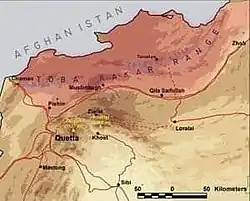Kingdom of Kaikan
The Kingdom of Kaikan (alternatively Kikan, Qaiqan or Qayqan) was a Jat kingdom in present-day Pakistan.[1] It played an important role in protecting Sindh from Arab invasions.[2] Over a period of 20 years, the Jats of Kaikan repulsed six invasions from the Umayyad Caliphate.[3]
Kingdom of Kaikan | |
|---|---|
| 7th century–9th century | |
 Kaikan Mountain in Red colour area | |
| Common languages | Sindhi |
| Religion | Hinduism |
| Government | Provincial Chiefs |
| History | |
• Established | 7th century |
• Disestablished | 9th century |
| Today part of | Pakistan |
History
.jpg.webp)
Kaikan, named after a mountain, was a small province in Sindh near the Bolan Pass.
The first raid is noted by Al-Baladhuri, Ibn Sa'd and Khalifah ibn Khayyat to have taken place in 658 AD. Kaikan was written as al-Qiqan by them and located near Quetta. Harith ibn Murrah al-Abdi and Sayfi ibn Fil al-Shaybani participated in this raid.[4]
The fourth Khalifa Ali sent the 2nd expedition to Sindh under Harith ibn Murrah al-Abdi in 660. After a successful raid in Sindh in 662, Harith turned his attention to Kaikan. Harith had outfitted a formidable Muslim army with nobles and chiefs. This army encountered no real opposition till it reached the treacherous terrain of Kaikan.[5] The Jats & Mers put up a tough fight against the Arabian invaders and decisively repulsed the attack.[6][7] Harith along with his followers was killed in the battle.[8][9] In an extraordinary battle, the Jats repelled them,[10] outclassing a vastly superior military force; superior in number, training, equipment and war experience. Only a handful of the large army could retreat & report the disaster to the Caliph. The casualties on the Jat side were quite significant but the Arab invaders had been decisively repulsed. This was a huge blow to the Caliph, and so, for the next twenty years, every successive Caliph made Kaikan a special target for conquest and sent as many as six expeditions, five of which failed to make any permanent impact in Sindh.[11]
When Muhammad bin Qasim (694-715) invaded Sindh, the Kaikan country was the independent possession of the Jats.[12] The country of Kaikan was supposed to be to the south-east of Afghanistan, which was conquered from the Jats by Arab general Imran bin Musa al Barmaki (son of Musa ibn Yahya) during the reign of the Khalifa Al-Mutasim-bi-llah (833-881). During his reign another expedition was sent against the Jats who had seized the roads to Hajar, spread terror there and set up posts in all directions towards the desert. They were overcome after a bloody conflict lasting twenty five days. 27,000 of them were held in captivity as a celebration of the Arab victory. It was a custom among these people to blow their horns when marshalled for battle.[13][14][15]
See also
References
- Barve, Shashikant V. (1995). Introduction to Classical Arabic: A Contribution to Islamic and Oriental Studies. S.V. Barve. p. 451.
- Journal of Indian History. Department of Modern Indian History. 1965.
- Balakrishna, Sandeep (2020). Invaders and Infidels (Book 1). New Delhi: Bloomsbury Publishing. ISBN 978-9390077229.
- Ibn Sa'd, 8:346. The raid is noted by Balâdhurî, "fatooh al-Baldan" p. 432, and Ibn Khayyât, Ta'rîkh, 1:173, 183–84. As cited in: Derryl N. Maclean, Religion and Society in Arab Sind. Pg. 126, EJ Brill: Leiden, 1989. ISBN 90-04-08551-3.
- Majumdar, R.C (2015). The History and Culture of the Indian People, Vol 3. Mumbai: Bharatiya Vidya Bhavan. p. 169.
- Aijaz Ahmad 2022, pp. 131–132.
- D. Rao, Vasant; Gokhale, Balkrishna Govind; D'Souza, A. L. (1966). Ancient Indian History and Culture. A.R. Sheth. p. 323.
- Aijaz Ahmad 2022, p. 132.
- D. Rao, Vasant; Gokhale, Balkrishna Govind; D'Souza, A. L. (1966). Ancient Indian History and Culture. A.R. Sheth. p. 323.
- Siddiqi, Amir Hasan (1971). Decisive Battles of Islam. Jamiyatul Falah Publications. p. 107.
- Majumdar, R.C. (2015). The History and Culture of the Indian People, Vol. 3. Mumbai: Bharatiya Vidya Bhavan. p. 174.
- Dīn, Malik Muḥammad (2001). Bahawalpur State with Map 1904 (reprint ed.). Bahawalpur: Sang-e-Meel Publications. p. 392. ISBN 978-9-693-5-12366.
- "University of Allahabad. Department of Modern Indian History, University of Kerala. Department of History, University of Travancore, University of Kerala". Journal of Indian History, Volume 43. Department of Modern Indian History. 1965.
- Indian Armed Forces Year Book. Bombay: Indian Youth (Ronuk Industries Ltd.). 1967. p. 452. Retrieved 11 July 2021.
- Barve, Shashikant V. (1995). Introduction to Classical Arabic: A Contribution to Islamic and Oriental Studies. S.V. Barve. p. 451.
Bibliography
- Aijaz Ahmad (2022). New Dimensions of Indian Historiography: Historical Facts and Hindutva Interpretation. New Delhi: K.K. Publications. ISBN 978-1-008-94572-2.